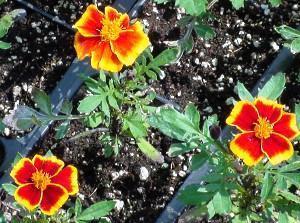How to grow marigolds on your site
 Marigolds (lat. Tagetes) are a herbaceous plant of the Astrov family with bright flowers of various colors. To date, more than 50 of their species are known. Annual and perennial marigolds are found in the wild. They are native to Latin and South America. Today, these flowers have spread almost all over the planet.
Marigolds (lat. Tagetes) are a herbaceous plant of the Astrov family with bright flowers of various colors. To date, more than 50 of their species are known. Annual and perennial marigolds are found in the wild. They are native to Latin and South America. Today, these flowers have spread almost all over the planet.
They are used not only for growing in flower beds, in mixborders, rabatkas, but also for medicinal purposes. Marigolds have a specific spicy aroma that is characteristic only of these flowers. It is caused by the presence of volatile bactericides called phytoncides.

When to plant marigolds for seedlings?
Marigolds reproduce by seeds. They are sown in spring. For these flowers, the principle operates according to which the earliest flowering is achieved by those who sow marigolds early. So from the moment of sowing to obtaining flowering plants, it takes about 2.5 months. With the seedling method of cultivation, seeds are sown in prepared boxes or pots with a nutrient substrate, in peat tablets in February-March. The optimum temperature for their germination is 22-25 ° C. Seedlings appear after a week.
Growing marigold seedlings is not difficult. Seedlings should only be watered periodically. Seedlings are kept until May in a warm and bright place. Gradually, young plants are accustomed to open air, taking out boxes with seedlings in the open air.
Only hardened seedlings can be planted outdoors. This is done when the threat of frost has passed.
Outdoor care for marigold seedlings
 In open ground, seeds are sown only after the soil has warmed up enough. This usually happens in May. The sunniest place is chosen for sowing seeds. Deep and wide holes are made in the ground, into which seeds are sown. In this case, the distance between them is about 2 cm, since thickened crops lead to the elongation of seedlings. Seeds are sprinkled with a thin layer of earth (1 cm) and watered abundantly.
In open ground, seeds are sown only after the soil has warmed up enough. This usually happens in May. The sunniest place is chosen for sowing seeds. Deep and wide holes are made in the ground, into which seeds are sown. In this case, the distance between them is about 2 cm, since thickened crops lead to the elongation of seedlings. Seeds are sprinkled with a thin layer of earth (1 cm) and watered abundantly.
Watering should be moderate prior to emergence. After their appearance, the earth should be constantly moistened. When 2-3 pairs of true leaves are formed, the seedlings are transplanted to a permanent place.
The best soil mixture for marigold seedlings consists of humus, peat, turf and sand in a ratio of 1: 1: 1: 0.5.
The seedlings of marigolds are planted by burying its stem a couple of centimeters into the ground. If there is a threat of frost, she may need a film cover.
It is impossible to fertilize young plants in the spring, as this will lead to intensive growth of the plant itself. In this case, flower buds will not form for a long time.
How to grow marigolds on a personal plot?
Planting marigold seedlings is a crucial moment in growing these flowers. For them, choose well-lit areas with soils of moderate moisture or good drainage.Marigolds can bloom and develop normally in light partial shade. They prefer fertile soils (neutral, loamy).
For growing marigolds, it is better to choose areas protected from the winds. Young plants develop well at an air temperature of 18-22 ° C.
After planting the mature seedlings in open ground, the plants are regularly fed with complex mineral fertilizers. The first feeding is carried out after the seedlings reach 10 cm in height and the first buds appear on them.
Fertilizers are applied once a month throughout the growing season. In the absence of dressing, marigolds can also develop well, but they will not bloom profusely.
These flowers tolerate transplanting normally at almost any period. They are unpretentious and very hardy. But, despite this, during the period of their active growth, they need good watering. After the formation of buds, an excess and stagnation of moisture in the soil often leads to rotting of the plant and its death. On hot summer days, one daily, evening watering is enough for marigolds.
Caring for these flowers consists of regularly loosening the soil and weeding. Loosening is necessary, since marigolds strongly need air and do not tolerate dense soils. Marigold bushes need to be pruned regularly, removing faded buds. This technique not only creates a beautiful plant, but also enhances flowering.
With an excess of moisture, these flowers are affected by fungus and rot. In case of drought, they can be attacked by a spider mite, which can be removed with insecticides (Actellik).
Many people consider marigolds to be simple flowers and just pass by, but I just adore them. I love to bend over and look at every flower. Each of them will be unique. These flowers are unpretentious to grow, disease resistant, and create a great mood due to their color. I give preference to undersized varieties. And what wonderful curly leaves they have. From the article I learned some practical advice about feeding. I didn't know what to do.